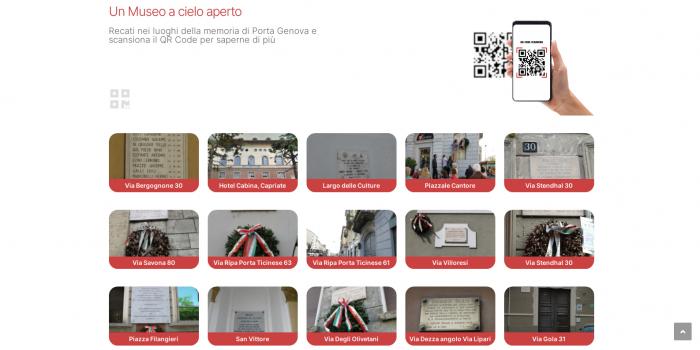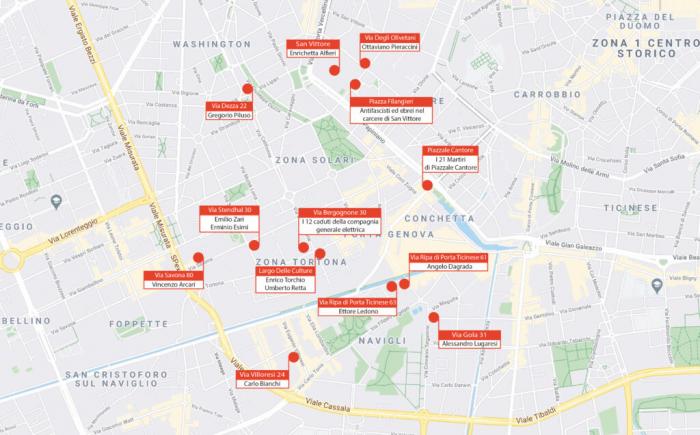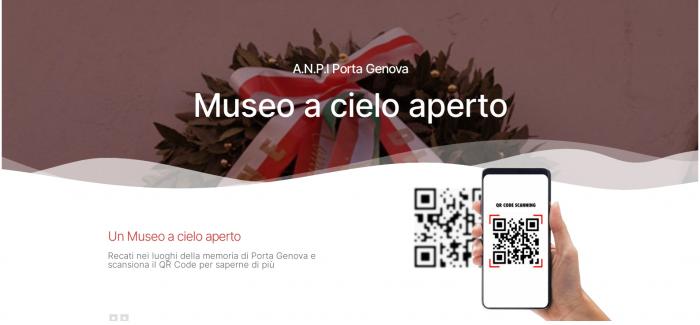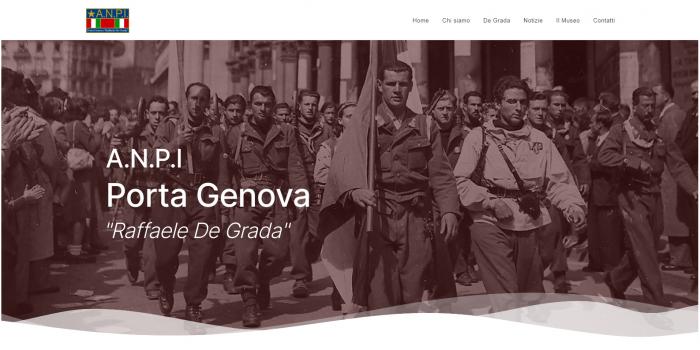I. SUMMARY INFORMATION
Project
268805
Status
Submitted
Award category
Preserved and transformed cultural heritage
You want to submit
NEW EUROPEAN BAUHAUS AWARDS : existing completed examples
Project title
Open-air Museum of the Resistance
Full project title
Open-air Museum of the Resistance: a virtual diffuse space of the memory in the cityscape
Description
The Open-air Museum of the Resistance uses digital tools to give access to the history hidden in our city. It enriches the places with information and value for an educational project aiming at involving the whole community. The developed project organizes the historical locations of the Italian liberation where partisans fought for freedom, in the city of Milan providing a map of the hot spots and gravestones that can be visited and they can deliver their storytelling to citizens and tourists.
Where was your project implemented in the EU?
Italy
Lombardy
Via Andrea Solari, 40
45° 27' 51.37" N
9° 11' 22.24" E
Milan
20144
When was your project implemented?
Has your project benefited from EU programmes or funds?
No
Which programme(s) or fund(s)? Provide the name of the programme(s)/fund(s), the strand/action line as relevant and the year.
II. DESCRIPTION OF THE PROJECT
Please provide a summary of your project
The “Open-air Museum of the Resistance” promotes widespread knowledge of the historical locations and values of our country. The museum is supported by ANPI (National Association of Italian Partisans) that between 2020 and 2021 started the digitization of their historical archive and realized a website for digital access to the information. The worldwide crisis due to the spread of Sars-Cov 2 (COVID-19) and the subsequent lockdown stopped the possibility to visit indoor museums and cultural activities, however, it stimulated the creation of a digital way of fruition and the proposal to implement an open-air historical “promenade”. The inability to move due to lockdowns, the use of the internet as a medium of cultural access, the change in the habits of young people with the use of smartphones for filtering their relationship with the world, and the accelerated economic growth towards delocalized commerce managed by web platforms, boosted the idea of transferring the same media also in the no-profit sector to enhance history and revive some symbolic places of a city. The project, in synthesis, concerns a possible way of connecting the actual world with the virtual reality that is used for enriching the user experience adding information and thus “voice” to the historical objects, in a dynamic and catchy users’ involvement. The hot spots in the city of Milan where the section ANPI Porta Genova is operating are connected in a systemic way through a city map where the locations are identified and can be visited and accessed in touristic and guided tours and the information about the historical events and gravestones of the Partisans that fought for the Italian Liberation can diffuse the values of freedom included in the national Constitution. The information can be accessed by a QR code which is situated on the documented locations creating a diffuse museum of urban history connected to the website of ANPI where focus on people, background, and events are provided.
Please give information about the key objectives of your project in terms of sustainability and how these have been met
The “Open-air Museum of the Resistance” promotes a walkable fruition of the historical “promenade” through the hot spots of the Partisans in the city of Milan. Using the map of the hot spots it is possible to organize the tour by foot or by bike and the main idea is to encourage a slow mode of achievement that is compliant to the “learning by doing and experience” approach. The Partisans died for their freedom and our present freedom and a low mode of visiting these locations and to access to the information enables to read and think about that sacrifice and the vision behind our national history. The current fast fruition of the internet contents has been coupled with a slow process of memory and learning. The “promenade” is open air, the project has no environmental impact, and it has a strong social outcome based on users’ civic growth through the knowledge of the common history and city. It can combine social segments and ages (e.g. old partisans and young students of the schools) in a virtual journey that enrich the value of the locations through the historic attributes. The project is web based and promote an immaterial and paper free approach. In fact, the first action was to transport on digital media of the paper and archival materials of the individual ANPI sections, responding to the request of the provincial ANPI of Milan. The section was born with the function, among the others, to look after the state and the memory of the gravestones of the Partisans died in each neighborhood, and the creation of the first “open-air museum” at national level starting from the first post-war period. The realization of the Open-air Museum of the Resistance reconstructs a thematic “promenade” through the city with milestones where to stop and enter the flow of history, open to all and in an economic way that moreover enhance the cityscape. The social, economic, and environmental aspects related to the sustainability have been part of the project concept.
Please give information about the key objectives of your project in terms of aesthetics and quality of experience beyond functionality and how these have been met
The “Open-air Museum of the Resistance” is based on a digital publication, divided by places, people, and colors. The focus is on the ANPI section of Porta Genova, a historical popular district in Milan located around the Navigli circle of canals. The website focuses on the correct historical reading of people, facts, and places related to the Resistance and the constitution of the Section. The graphic project was carried out by young graduates of the Politecnico di Milano University of Architecture, providing a young and captivating virtual environment for the young target users of the website and virtual tour fruition. The free press site makes easy the management and the future enrichment with further information and enables the handover to other young subjects in the future developments. The website includes the mapping of the gravestones in the Porta Genova district made as a phase of the project development. Each page of the website is divided into places where the story related to the name and date of a gravestone encountered along a road has been reconstructed through texts and images. Over time it will be possible to integrate the present iconographic supports with information, for example regarding the urban transformations. This will enhance the users' experience and knowledge of the city and history. The realization of the QR codes has been performed through free software to transform the address line of each webpage into a code. These codes have been customized with the ANPI section logo in format 7×7 cm, and printed in an A4 transparent adhesive sheet (tests have been carried out with stencils for spray and printing on aluminum). These solutions have been evaluated and tested to preserve the aesthetic value of the locations and gravestones adding the historic information with a respectful and light aesthetic result. A possible implementation could involve the AR/VR that could be added to visualize external information or video contents.
Please give information about the key objectives of your project in terms of inclusion and how these have been met
The project “Open-air Museum of the Resistance” has the main objective of inclusion that is promoted through widespread knowledge and extended participation. The organization of the archives and traditional documents and materials of the ANPI in the dedicated website improves the accessibility of the information to the local and external audience. The knowledge of the history and the preservation of the cultural heritage endorses shared civic and social values that are a paramount community glue. Social cohesion and identity is not a barrier to the hybridization and openness to a wide cultural inclusion, on the contrary, the knowledge of the past and the fights for national Liberation can promote a culture of comprehension and inclusion of all the people who everyday fight for freedom and a better future. The project is accessible on the website www.anpiportagenova.it that is the public website of ANPI (National Association of Italian Partisans) and it has been disseminated through papers published in the national and local press. The city map with the QR codes applied on the hot spots can be visited by locals and tourists. Moreover, it might be promoted activities of “historical tour guides” that can share their storytelling in addition to the information retrievable by the website. This could be interesting for example for school visits but also for tourists and for all the citizens and the urban community, giving special recognition to Partisans who can share their first-hand experiences. Moreover, the possibility to cross ages (old partisans and young students) extends the potential inclusion creating mixed groups that can benefit each other of the social exchange. A future extension of the project focus on the realization of informative totems in Plexiglas that can be located in the hot spots and that can enable the informative content for visually impaired people for whom it possible also to provide audio guides to extend the use of information.
Please give information on the results/impacts achieved by your project in relation to the category you apply for
The project “Open-air Museum of the Resistance” is presented in the category “Preserved and transformed cultural heritage”. The assumption that the national Liberation, and thus the subsequent Constitution, is a milestone of our national history is at the basis of ANPI (National Association of Italian Partisans) activities and of the project. The engagement of Studio Jam in realizing this self-produced project through the passionate contribution of the Politecnico students of Architecture comes from the social promotion of a collective vision that supports free thinking against oppressive regimes and divisive ideas and adopts new methods and technologies for the preservation of the cultural heritage. The project achieves the transmission of information by digital tools and makes accessible the knowledge of a crucial cultural heritage for our future social progress in a period of crisis in which in some cases the mainstream thinking has been demonstrated to lose social values and support of the preservation and defense of human rights. The history of Partisans and Liberation has a global and transnational worth of social support and benefit for the community through the shared values of freedom and individual thinking against regimes ideas and mainstream deviated politics. The project speaks to young people, children, and students that have to develop their critical thinking and understand that the knowledge of history is crucial to not repeat it. The imprints that history has left in the city are multiple and it is not easy to recognize them and to define a cultural cityscape. Moreover, there is a great deal of historical layering that includes several eras, and selecting a period that is particularly significant to national history presented a challenge to thematize the cityscape. For that reason, the project defines these trajectories and paths where history is surveyed and notarized accomplishing to transfer the information in a smart and enjoyable way.
Please explain the way citizens benefiting from or affected by the project and civil society have been involved in the project and what has been the impact of this involvement on the project
The project “Open-air Museum of the Resistance” comes from the fruitful dialogue of Studio Jam with the ANPI section of Porta Genova, and it was organized as a development activity among different sections and possibly will be transferred at the national level. The project of connecting the city with its history and providing a memory journey supported by digital technologies has been discussed and presented to the local teaching staff of schools located in the Porta Genova district as well as to the Municipality of Milan, (the president of the city council, the councilor for the cultural activities and the councilor for the urban development) as the project is related to the cultural landscape and to the local area linking the memory line and the urban pathways. The transdisciplinary project enabled by digital technologies enhances the access to information about the cultural heritage and the memory preservation of the places where the history happened. The ANPI supported the research about the cultural heritage and the people that have made history, the digitalized archived material came from different sources (i.e. public library, private documents, and images collected by the local community). The contribution of the schools will be a cultural diffusion of the information about the Partisans and the Liberation. In 2022 will be organized, together with the middle schools and teachers, guided tours through the city neighborhoods to learn about the Constitution through the history of the Partisans. A possible project extension discussed with the participation of the schools concerns the possible implementation of the existing school websites with archive sources relating to the two wars, including cards regarding the number of discriminated and deported teachers and children during the war, and the use of QR codes at the entrances of the schools to remember and increase the understanding of a tragic but significant page of national and European history.
Please highlight the innovative character of the project
aThe project “Open-air Museum of the Resistance” links significant places in the city where gravestones and memorial plaques are located while the growth of the urban development is unstopped. It is important to emphasize and underline the memory of places and to promote a reading of the city in the multiplicity of significance that the history has carved. This process is a driver for civic awareness, particularly paramount at the national level, to stimulate cultural community evolution. The use of QR codes to enrich the information content is used in museums and it is a consolidated technology however the use of this system for an Open-air museum is a novel approach and the structure of a map of hot spots where information are made available through this technology can be considered as a noteworthy innovation. The idea of a virtual diffuse space of the memory in the cityscape is the key innovation of the project developed by Studio Jam that realized transversal storytelling that unifies people, history, locations, and city development. The regeneration of our city is an essential process that has to be carried out with sensitivity and attention to the history hidden in the specific urban points and to enlighten these places is socially extremely important to consolidate the cultural heritage and preserve the social value in the future generations. The renovation processes that are transforming our cities can be supported by this kind of cultural-historical heritage preservation network enabled by digital technologies accessible to all. In this global pandemic situation, a last remark is noworthy, the digitalization of the cultural heritage and the possibility to access in an open-air diffuse cultural environment convert our cities into extended museums embracing innovation and transformation and promoting cultural growth furthermore when the indoor space can be seen as critical for epidemic reasons. The use of outdoor space is a revamp for the living models.
Please explain how the project led to results or learnings which could be transferred to other interested parties
The project “Open-air Museum of the Resistance”, born as open-source with no copyrights and the promoters hope is that it could be replicated in other sections and contexts with the proposed method that links the locations and the cultural heritage through accessible digital information for preservation and social-cultural support. The project was entirely self-produced with no cost for ANPI association in order to reactivate the internal resources of the sections, to involve the members in common actions (e.g. data collection, documents analysis, organization of the communication strategy, etc.) and accordingly pay homage to the values of the Resistance for the national Liberation (25 April 1946 Liberation of Italy from the Nazi occupation and the fascist regime). The concept can be easily reshaped for educational purposes in other areas of the territory where important historical signs can be re-experienced and valued, such as the school archives between the two wars. The national context and the European countries are rich in important and emphasized historic places that are visited by schools and tourists every year. Nevertheless, the diffuse urban approach to cultural heritage can include in the everyday life the value of history and the love for the places providing new identity to our cities through the sustainable way of visiting and digital access to the information even on a smaller scale. The approach is scalable and replicable in the European context through thematic pathways base on different historical layers.
Is an evaluation report or any relevant independent evaluation source available?
No
III. UPLOAD PICTURES
IV. VALIDATION
By ticking this box, you declare that all the information provided in this form is factually correct, that the proposed project has not been proposed for the Awards more than once under the same category and that it has not been subject to any type of investigation, which could lead to a financial correction because of irregularities or fraud.
Yes




